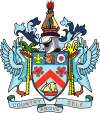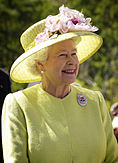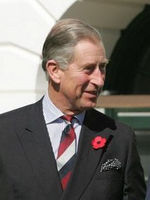- Monarchy of Saint Kitts and Nevis
-
This article is about the monarchy of Saint Kitts and Nevis. For information on the other countries which share the same monarchy, see Commonwealth realm.
Queen of Saint Kitts and Nevis Monarchy 
Coat of arms of Saint Kitts and Nevis
Incumbent:
Elizabeth IIStyle: Her Majesty Heir apparent: Charles, Prince of Wales First monarch: Elizabeth II Formation: September 19, 1983 [1] The monarchy of Saint Kitts and Nevis (the Kittitian and Nevisian monarchy) is a system of government in which a hereditary monarch is the sovereign of Saint Kitts and Nevis. The present monarch of Saint Kitts and Nevis is Queen Elizabeth II.[2] Saint Kitts and Nevis share the Sovereign with a number of Commonwealth realms.[2][1] The Queen's constitutional roles are mostly delegated to the Governor-General of Saint Kitts and Nevis. Royal succession is governed by the English Act of Settlement of 1701, which is part of constitutional law. [3] [4]
Saint Kitts and Nevis 
This article is part of the series:
Politics and government of
Saint Kitts and Nevis- Queen
- Elizabeth II
- Governor-General
- Prime Minister
- National Assembly
- Speaker
- Curtis Martin
- Speaker
- Political parties
- Elections: 2004, 2010
- Parishes
- Foreign relations
Nevis

- Premier
- Nevis Island Administration
- Nevis Island Assembly
Contents
International and domestic role
One of the most complicated features of the Saint Kitts and Nevis Monarchy is that it is a shared monarchy.
54 states are members of the Commonwealth of Nations. Sixteen of these countries are specifically Commonwealth realms who recognise, individually, the same person as their Monarch and Head of State;Saint Kitts and Nevis is one of these.[5] Despite sharing the same person as their respective national monarch, each of the Commonwealth realms — including Saint Kitts and Nevis — is sovereign and independent of the others.
The Balfour Declaration of 1926 provided the dominions the right to be considered equal to Britain, rather than subordinate; an agreement that had the result of, in theory, a shared Crown that operates independently in each realm rather than a unitary British Crown under which all the dominions were secondary. The Monarchy thus ceased to be an exclusively British institution, although it has often been called "British" since this time (in both legal and common language) for reasons historical, legal, and of convenience. The Royal and Parliamentary Titles Act, 1927 was the first indication of this shift in law, further elaborated in the Statute of Westminster, 1931.
Under the Statute of Westminster, Saint Kitts and Nevis has a common monarchy with Britain and the other Commonwealth realms, and though laws governing the line of succession to the Saint Kitts and Nevis throne lie within the control of the Saint Kitts and Nevis Parliament, Saint Kitts and Nevis cannot change the rules of succession without the unanimous consent of the other realms, unless explicitly leaving the shared monarchy relationship by means of a constitutional amendment. This situation applies symmetrically in all the other realms, including the UK.
On all matters of the Saint Kitts and Nevis State, the Monarch is advised solely by Saint Kitts and Nevis ministers.
Title
In Saint Kitts and Nevis, the Queen's official title is: Elizabeth the Second, by the Grace of God, Queen of Saint Christopher and Nevis and of Her other Realms and Territories, Head of the Commonwealth.
This style communicates Saint Kitts and Nevis's status as an independent monarchy, highlighting the Monarch's role specifically as Queen of Saint Kitts and Nevis, as well as the shared aspect of the Crown throughout the realms. Typically, the Sovereign is styled "Queen of Saint Kitts and Nevis," and is addressed as such when in Saint Kitts and Nevis, or performing duties on behalf of Saint Kitts and Nevis abroad.
Constitutional role
The Saint Kitts and Nevis constitution is made up of a variety of statutes and conventions that are either British or Saint Kitts and Nevis in origin, which gives Saint Kitts and Nevis a similar parliamentary system of government as the other Commonwealth realms.
All powers of state are constitutionally reposed in the Monarch, who is represented by the Governor General of Saint Kitts and Nevis — appointed by the Monarch upon the advice of the Prime Minister of Saint Kitts and Nevis the Monarch is informed of the Prime Minister's decision before the Governor General gives Royal Assent.
Duties
Most of the Queen's domestic duties are performed by the Governor General. The Governor-General represents the Queen on ceremonial occasions such as the opening of Parliament, the presentation of honours and military parades. Under the Constitution, he is given authority to act in some matters, for example in appointing and disciplining officers of the civil service, in proroguing Parliament. As in the other Commonwealth realms, however, the Monarch's role, and thereby the vice-regent's role, is almost entirely symbolic and cultural, acting as a symbol of the legal authority under which all governments operate, and the powers that are constitutionally hers are exercised almost wholly upon the advice of the Cabinet, made up of Ministers of the Crown. It has been said since the death of Queen Anne in 1714, the last monarch to head the British cabinet, that the monarch "reigns" but does not "rule". In exceptional circumstances, however, the Monarch or vice-regal can act against such advice based upon his or her reserve powers.
There are also a few duties which must be specifically performed by, or bills that require assent by the Queen. These include: signing the appointment papers of Governors General, the confirmation of awards of honours, and approving any change in her title.
It is also possible that if the Governor General decided to go against the Prime Minister's or the government's advice, the Prime Minister could appeal directly to the Monarch, or even recommend that the Monarch dismiss the Governor General.
Succession
 Charles, Prince of Wales, the current heir to the throne of Saint Kitts and Nevis
Charles, Prince of Wales, the current heir to the throne of Saint Kitts and Nevis
Succession to the throne is by male-preference primogeniture, and governed by the provisions of the Act of Settlement, as well as the English Bill of Rights. These documents, though originally passed by the Parliament of England, are now part of the Saint Kitts and Nevis constitutional law, under control of the Saint Kitts and Nevis parliament only.
This legislation lays out the rules that the Monarch cannot be a Roman Catholic, nor married to one, and must be in communion with the Church of England upon ascending the throne. As Saint Kitts and Nevis's laws governing succession are currently identical to those of the United Kingdom (by the Statute of Westminster) see Succession to the British Throne for more information.
The heir apparent is Elizabeth II's eldest son, Charles, who has no official title outside of the UK, but is accorded his UK title, Prince of Wales, as a courtesy title.
Legal role
All laws in Saint Kitts and Nevis are enacted with the sovereign's, or the vice-regal's signature. The granting of a signature to a bill is known as Royal Assent; it and proclamation are required for all acts of Parliament, usually granted or withheld by the Governor General. The Vice-Regals may reserve a bill for the Monarch's pleasure, that is to say, allow the Monarch to make a personal decision on the bill. The Monarch has the power to disallow a bill (within a time limit specified by the constitution).
The Sovereign is deemed the "fount of justice," and is responsible for rendering justice for all subjects. The Sovereign does not personally rule in judicial cases; instead, judicial functions are performed in his or her name. The common law holds that the Sovereign "can do no wrong"; the monarch cannot be prosecuted in his or her own courts for criminal offences. Civil lawsuits against the Crown in its public capacity (that is, lawsuits against the government) are permitted; however, lawsuits against the Monarch personally are not cognizable. The Sovereign, and by extension the Governor General, also exercises the "prerogative of mercy," and may pardon offences against the Crown. Pardons may be awarded before, during, or after a trial.
In Saint Kitts and Nevis the legal personality of the State is referred to as "Her Majesty the Queen in Right of Saint Kitts and Nevis." For example, if a lawsuit is filed against the government, the respondent is formally described as Her Majesty the Queen in Right of Saint Kitts and Nevis. The monarch as an individual takes no more role in such an affair than in any other business of government.
References
- ^ a b The Monarchy Today > Queen and Commonwealth
- ^ a b http://www.gov.kn/ct.asp?xItem=462&CtNode=58&mp=1
- ^ Official text of the statute as amended and in force today within the United Kingdom, from the UK Statute Law Database
- ^ Text of the Act of Settlement as originally passed [Chapter II. Rot. Parl. 12 & 13 Gul. III. p. 1. n. 2.]', Statutes of the Realm: vol 7: 1695-1701 (1820), pp. 636–38.
- ^ The Monarchy Today > Queen and Commonwealth > Members
See also
Other realms
Other
- Figurehead
- Prime Ministers of Queen Elizabeth II
- List of Commonwealth visits made by Queen Elizabeth II
- Monarchies in the Americas
- List of monarchies
Commonwealth realms Current Former Ceylon · Fiji · Gambia · Ghana · Guyana · India1 · Ireland1 · Kenya · Malawi · Malta · Mauritius · Newfoundland2 · Nigeria · Pakistan · Rhodesia3 · Sierra Leone · South Africa · Tanganyika · Trinidad and Tobago · Uganda
1 Dominion, became republic before adoption of the term "realm"
2 Dominion, never ratified Statute of Westminster 1931, London-based external government 1934–1949, annexed by Canada in 1949
3 Southern Rhodesia unilaterally declared independence as Rhodesia in 1965, claiming to be a Commonwealth realm, but this was unrecognised by the United Kingdom. Rhodesia then declared itself a republic in 1970.Monarchies in the Americas Current Indigenous monarchiesAntigua and Barbuda · The Bahamas · Barbados · Belize · Canada · Grenada · Jamaica · Saint Kitts and Nevis · Saint Lucia · Saint Vincent and the GrenadinesSettled monarchiesFormer Indigenous monarchiesAraucania and Patagonia · Aztec · Brazil · Haiti (1804-1806) · Haiti (1811-1820) · Haiti (1849-1859) · Inca · Maya · Mexico (1822-1823) · Mexico (1864-1867) · Miskito · TaínoColonial monarchiesRelated List of monarchs in the Americas · List of the last monarchs in the AmericasQueen Elizabeth II Monarchies - Queen of Antigua and Barbuda
- Queen of Australia
- Queen of the Bahamas
- Queen of Barbados
- Queen of Belize
- Queen of Canada
- Queen of Grenada
- Queen of Jamaica
- Queen of New Zealand
- Queen of Papua New Guinea
- Queen of Saint Kitts and Nevis
- Queen of Saint Lucia
- Queen of Saint Vincent and the Grenadines
- Queen of the Solomon Islands
- Queen of Tuvalu
- Queen of the United Kingdom
- Prime Ministers

Titles and honours Overseas visits Public celebrations - Wedding to Philip, Duke of Edinburgh
- Coronation
- Silver Jubilee
- Golden Jubilee
- Diamond Jubilee
- Queen's Official Birthday
- Victoria Day
Categories:- Politics of Saint Kitts and Nevis
- Government of Saint Kitts and Nevis
- Monarchy of Saint Kitts and Nevis
- Queen
Wikimedia Foundation. 2010.
